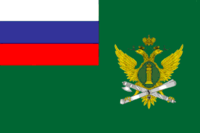Federal Bailiffs Service (Russia)
| Federal Bailiffs Service | |
|---|---|
 FSSP logo | |
 | |
| Abbreviation | FSSP |
| Agency overview | |
| Formed | November 6, 1997 as Department of Bailiffs |
| Employees | 74,559 |
| Legal personality | Governmental: Government agency |
| Jurisdictional structure | |
| National agency | Russia |
| Federal agency | Russia |
| Operations jurisdiction | Russia |
| Governing body | Ministry of Justice (Russia) |
| General nature | • Federal law enforcement |
| Headquarters | 16 Kuznetsky Most, Moscow |
|
| |
| Agency executive |
|
| Parent agency | Russian Ministry of Justice |
| Website | |
|
www | |
Federal Bailiffs Service or Federal Service of Court Bailiffs (FSSP of Russia, in Russian: Федеральная служба судебных приставов Federalnaya Sluzhba Sudebnykh Pristavov, FSSP Rossii) - is a federal law enforcement agency within the Russian ministry of Justice. It was created in November 1997 during the presidency of Boris Yeltsin. The Service is attached to the Judicial branch of government, and is the enforcement arm of the federal courts. It is the primary agency for fugitive operations, responsible for the protection of officers of the court, and for the effective operation of the judiciary, and also charged with providing security services and maintaining order within court facilities across Russia.
Functions and Powers
- Prisoner transport and processing
- Judicial security
- Bailiff
- Courthouse Security
- 24-hour prisoner lockup jails and cell blocks
- protection of court buildings
- guard services to judges
The Bailiffs Service is the only authorized body of the Russian executive authority coercing the execution of the judicial decision. The Service ensures proper and timely execution of judicial acts, acts of other bodies and officials, as well as in cases stipulated by the legislation of the Russian Federation, execution of other documents in order to protect the abused rights, freedoms and legitimate interests of citizens and organizations.
Federal Bailiffs are required to be biennially certified in the use of pepper spray, handcuffs, and defensive batons.
The Federal Bailiffs may search people as they enter the court and remove them if they refuse to be searched, they can also remove people in order to enable court business to be carried on without interference or delay, maintain order and secure the safety of any person in the court building. Officers may ask a person to surrender (and failing that seize) property if they believe it may jeopardise the maintenance of order in the court, put the safety of any person in the court building at risk, or may be evidence of, or in relation to, an offence.
History
The Bailiffs’ Service formed in 1997, when federal laws No. 118 from July 21, 1997 "On Bailiffs" and Federal law 119 "On Enforcement Proceedings" were adopted. These laws fundamentally changed the system of enforcement proceedings in Russia and were legal basis for organizing an independent institution of bailiffs, and was known as The Department of Bailiffs of the Justice Ministry, and was acting under the order of the Russian Ministry of Justice from September 22, 2000 "On Approval of the Department of Bailiffs".
The Department became a Federal Service after it was formed by the Decree of the President of Russia Vladimir Putin, from March 9, 2004, Decree Number 314 "On the system and structure of the federal executive authorities".
Directors
| # | Name | Term | Notes |
|---|---|---|---|
| 1 | Boris Kondrashov | November 6, 1997 – September 1999 | First Director of the Bailiffs Department; Deputy for the Justice Minister |
| 2 | Arkady Melnikov | November 1999 – October 2004 | Director of the Bailiffs Department; Deputy for the Justice Minister |
| 3 | Nikolai Vinichenko | October 21, 2004 – December 29, 2008 | First Director of Federal Bailiffs Service, Chief Bailiff of the Russian Federation |
| 4 | Artur Parfenchikov | December 29, 2008 – February 15, 2017 | Director of the Federal Bailiffs’ Service – Chief Bailiff of the Russia; appointed as Head of the Republic of Karelia |
| 5 | Sergey Sazanov | February 15, 2017 – | Acting Director of the Federal Bailiffs’ Service – Chief Bailiff of the Russian Federation |
See also
References
External links
| Wikimedia Commons has media related to Federal Bailiffs Service (Russia). |
- Official website (in Russian)

